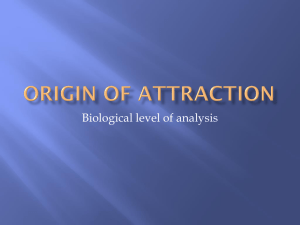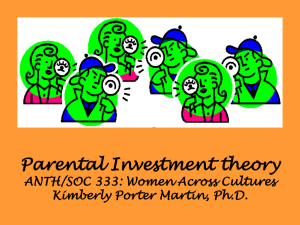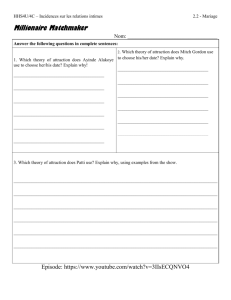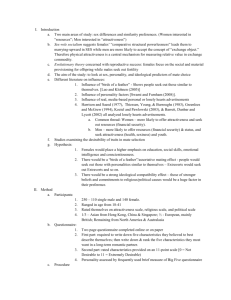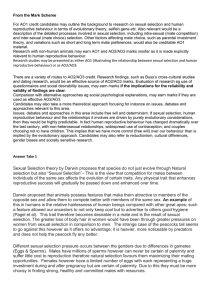buss powerpoint (NM 2013)
advertisement
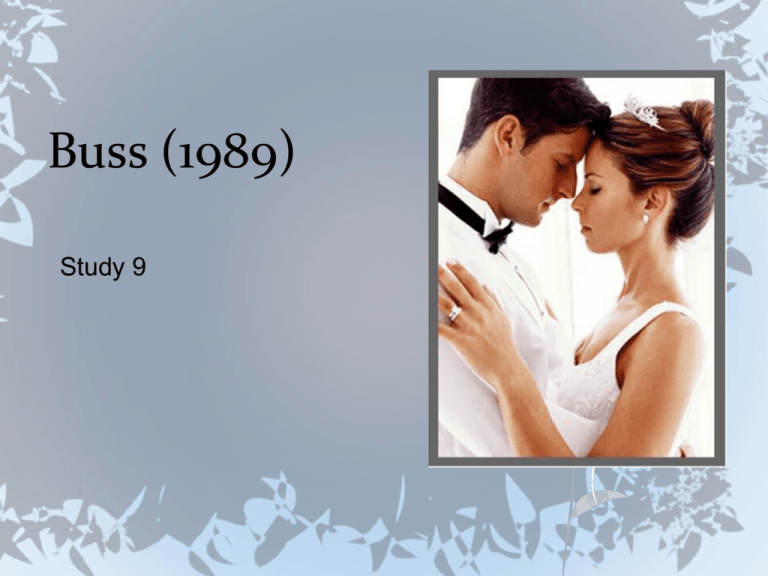
Buss (1989) Study 9 Mate preferences You have to marry one of these people. Who and why? (they are all actors) Evolutionary recap Bennett-Levy and Marteau = evolution of phobias for survival Buss = evolution of mating preferences for reproduction What behaviour would lead to increased/ decreased success at reproduction? 1. Context If humans have evolved, characteristics that increase the success of reproduction should appear more often in the population Thornhill and Thornhill (1983) People lacking these characteristics will not be able to mate and to become people’s ancestors 1. Context Current mate preference is of interest to evolutionary psychologists as it tells us about past reproductive history. Mate preference is important, but little is known about the characteristics which are valued by males and females. Context 3 theories about mate selection One theory each Have to explain in a stickman poster No more than 10 words 1. Context 1. Prediction based on parental investment (Trivers, 1972) Who invests the most time, energy and resources in raising children? Female investment is huge, while male investment is minimal 1. Context 1. Prediction based on parental investment Prediction: women will look for men who can offer resources and protection for both her and her future children In modern times, this might not be food and shelter, as much as money and status. 1. Context 2. Prediction based on reproductive value (Symons, 1979) and fertility (Williams 1975) Fertility: probability of reproducing now Reproductive value: probability of reproducing in the future 35 year old vs 10year old Male vs female What age would the ideal mate be? 1. Context 2. Prediction based on reproductive value and fertility Youthfulness is a sign of both fertility and reproductive value: good skin, muscle tone full lips and healthy hair Prediction: as female fertility is related to age, we would predict that men show a preference for younger women. Preference less pronounced in women. 1. Context 3. Prediction based on paternity probability (Daly et al, 1982) How certain can a woman be that any child she has is hers? How certain can a man be that his mate’s child is his? Males want to be certain that they are investing time and resources into their own offspring. 1. Context Prediction based on paternity probability Prediction: males should show a greater preference for women who are chaste (i.e. virgins) As women know that any child they have is theirs, this will be less important However, males with other partners might have to share resources... 1. Aim To investigate if evolutionary explanations for sex differences in human mate preferences are found cross culturally Why use cross cultural studies for evolutionary theories? 2. Procedure Buss used a questionnaire which assessed preferences for particular traits in potential mates Using pg 117 in the book, find out the missing information about the participants Identify the sampling techniques used 2. Procedures Instrument 1: Rating What issues did you find with the first questionnaire? Why not just ask about the four critical factors? 2. Procedures Instrument 2: Ranking Putting 13 characteristics in rank order What problems are there with ranking? 2. Procedures Translations Translated into local languages Avoiding of gender specific terms Adapted to fit customs Co-habiting in Sweden Polygyny in Nigeria Is this a strength or a weakness? 3. Findings Significance recap: If it is “significant” there is less than a 5% probability that it is due to chance Financial prospects: in 36/37 samples women valued “good financial prospects” higher than men. Large variation between and within cultures in importance. High value in Africa, Asia and America. Lower in Europe 3. Findings Ambition and industriousness In 34/37 samples females desired ambition higher than males 3/37 males had a higher preference in women In these cultures, women carry out many physical tasks Not rated low in any sample, although UK, Germany, Netherlands and Finland showed less preference 3. Findings Age Difference In every sample, men preferred younger women (2.66 years) Mean age men want to marry: 27.49 years. Therefore ideal age for females to be is 24.83 This is closer to peak fertility rather than peak reproductive value 3. Findings Age differences Females preferred older men (3.42 years) Mean age females want to marry: 25.39 years. Therefore ideal age for males to be is 28.81 Where polygyny is common, desired age difference for men is bigger In these cultures, men are older when they marry 3. Findings Good Looks In all samples, men rated good looks as more important than women Chastity Large variation in the importance of chastity In 23/37 males valued chastity as higher than females. Important in China, India, Indonesia, Iran Taiwan and Palestine Seen as irrelevant in most European samples 3. Findings 3. Conclusions There are five conclusions in this study. Each one relates to one of the three theories from the context. Read the conclusions and match to the theory (use the psychologists names) 3. Conclusions How do Buss’s findings support the general notion of mating behaviour being innate? Traits are universal. If they were all different, we could argue it is due to culture. But as they are the same everywhere, is suggests a biological basis for behaviour. Also, the behaviour shown matches what we would predict from evolutionary theory. 3. Conclusions Mating behaviour differs by gender. This reflects the differences in the reproductive capacities of males and females. Unlike animals, human mate preference is not simply about female choosiness. Males and females both express preferences. However, Buss also highlighted that there are cultural influences as well. This is demonstrated by the large differences in preferences for chastity between cultures. …found on the internet Does this fit with Buss’s findings? 5. Alternative Evidence Buss found that physical attractiveness was rated highly by nearly all male samples. But why? What is “attractiveness”? Is it the same in all cultures? Why… Not… 5. Alternative Evidence Cunningham et al (1995): close agreement across cultures in female physical attractiveness. Native Asians and Hispanic students and white Americans rated attractiveness of Asian, Hispanic, black and white women. Mean correlation between groups in attractiveness ratings was +0.93. 5. Alternative Evidence Which woman is most attractive? 5. Alternative Evidence Singh (1993): waist to hip ration (WHR) related to physical attractiveness across cultures. Men prefer women who have a low WHR. A woman with this WHR is likely to have a large bottom (good fat reserves for pregnancy) and a narrow waist (indicating that she is not pregnant) Low WHR would is attractive because it is a sign of youthfulness and fertility. 5. Alternative Evidence Which face is more attractive? 5. Alternative Evidence Which face is more attractive? 5. Alternative Evidence Which face is more attractive? 5. Alternative Evidence Facial symmetry may be a sign of genetic strength. Therefore, symmetrical faces may be more attractive. Little et al (2007) examined preferences for symmetry in both the UK and the Hadza, a primitive hunter gatherer society in Tanzania. Both groups preferred symmetrical faces, and this was the strongest in the Hadza. 5. Alternative Evidence Schmitt (2003) 16,288 people from 53 countries Found universal differences between Male and Female mate choice. Found in ALL countries men desired a larger number of mates than women did. What does this suggest about Buss’s conclusions? 5. Alternative Evidence How much do people's stated preferences actually reflect their choices? Waynforth and Dunbar (1995) content analysis of 900 lonely hearts ads, and noted differences in what men and women want. More men than women sought a youthful mate More men sought a physically attractive mate More women used physically attractive terms to describe themselves More men reported their economic status/earning power when describing themselves. 5. Alternative Evidence Buss focused on heterosexual relationships. Can we apply to homosexual relationships? Dunbar (1995) looked at gay personal ads, Heterosexual women were three times more likely to seek resources and status then lesbians, Gay men offered resources about half as often as heterosexual men. This supports the evolutionary explanation; we would not expect lesbian and gay mate choice to be related to reproductive criteria. 5. Alternative Evidence Dunbar also notes that times have changed, Women have their own economic security, are less interested in a partner’s resources. Seek instead a caring, sharing partner instead This still makes evolutionary sense because that kind of partner should still enhance reproductive success. Use three colours to highlight research that supports, contradicts, or develops Buss’s research

